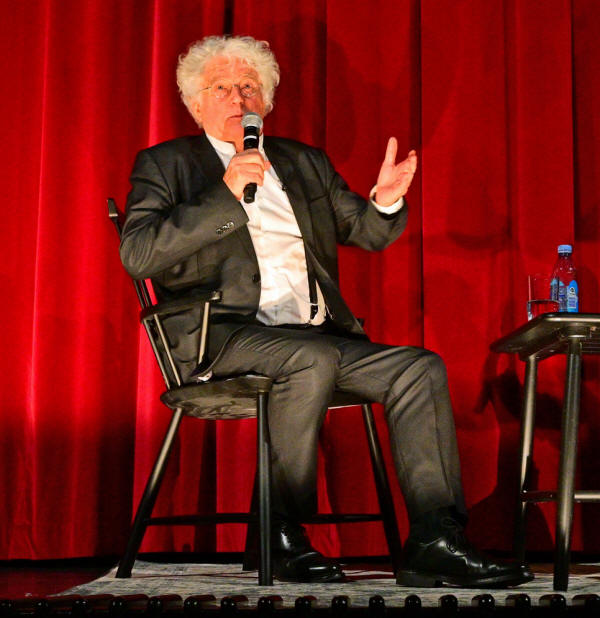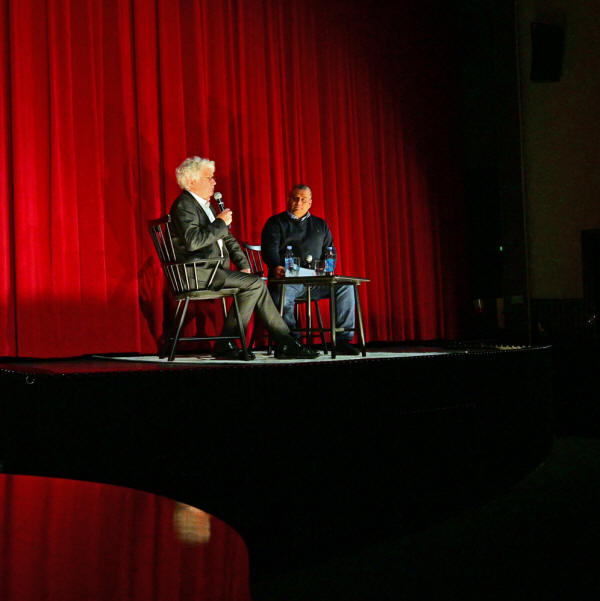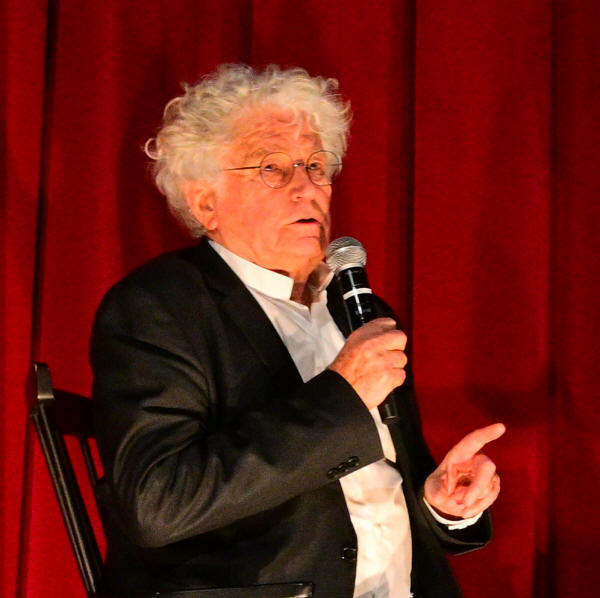Jean-Jacques Annaud's Introduction to "The Bear" |
Read more at in70mm.com The 70mm Newsletter |
| Intro transcribed and edited for clarity by: Mark Lyndon and Margaret Wedon, in70mm.com, London Branch | Date: 01.07.2023 |
 Jean-Jacques Annaud
and Sune Lind Thomsen, Gentofte Kino on stage. Picture: Thomas Hauerslev Jean-Jacques Annaud
and Sune Lind Thomsen, Gentofte Kino on stage. Picture: Thomas HauerslevSune Lind Thomsen, Gentofte Kino: All the way from Paris, just to be here tonight. Please welcome Mr. Jean-Jacques Annaud [APPLAUSE]. Welcome - it is good to have you back here. This is really important for the Cinema, and also something that is close to your heart – the 70MM experience. We will talk about "The Bear" of course. Jean-Jacques Annaud. Each time I come to Copenhagen I am pleased to see so many beautiful people and it is good to be back here. SLT: Tell me what is it about the 70MM experience that we are going to see tonight that is so extraordinary? What makes it very different? JJA: Frankly, I am curious to see this movie again because the last time I have seen it was in Los Angeles when I did the grading myself for 70MM – I checked the timing to optimize the print. The movie has been shot in anamorphic CinemaScope in 35mm, the advantage being that standard 35mm [1,66:1 or 1,85: widescreen] has a smaller image area on the film stock than the anamorphic. I am sure professionals here will know that we are using the full film [in 70mm], while in 35mm we leave space for the soundtrack. • Go to The Immersive Quality of 70mm Film • Go to A Conversation with Jean-Jacques Annaud, Director of "The Bear" • Go to GIFF 70, Gentofte International Film Festival, Copenhagen, Denmark Today, what makes a big difference is not only that 70MM has more definition than when you blow up from a 35mm negative, on 70MM the image has more definition because the positive is better. This is very technical but even if it is shot on 35mm, the 70MM print will be sharper, but the even larger difference is the magnetic sound. I am very sad that those movies from the '70 and '80, which were released in 70MM are lost in a way. The transfers onto DVDs are very often in 5.1 sound or even less – very often just simple stereo. But here you are going to see the movie with 6 tracks. It is like a first attempt of what we call ATMOS today with 75 speakers, and remember in those days there were only 6 tracks – I remember I was very pleased with the sound. Very few people got to see it in a proper cinema well equipped for 70MM. Even in those days I think we had 400 cinemas in France, but there were only 30 cinemas that could handle the [70mm] print - with 400 cinemas playing the movie. SLT: We will stay with the technical aspects because six track magnetic sound is like the old tape recording but the sound is so much better. So the sound is full and rich and very organic. When we try to transfer this into our cinema here tonight, even though it is an old print - one of the original prints – we will see this film with French subtitles in the English language. That is the proper one – right? JJA: There are at least three pages of dialogue in this movie but they are very important. When I was pitching the movie in Los Angeles, they loved the story and the screen play. Then they said "OK who is playing the bear?!" |
More in 70mm reading: A Conversation with Jean-Jacques Annaud, Director of "The Bear" (1988) “The Bear” (also known as “L’Ours”): The 70mm Engagements “Quest for Fire”: The North American 70mm Engagements GIFF 70, Gentofte International Film Festival, Copenhagen, Denmark in70mm.com's Library Presented on the big screen in 7OMM Peripheral Vision, Scopes, Dimensions and Panoramas |
 "Today,
what makes a big difference is not only that 70MM has more definition than
when you blow up from a 35mm negative, on 70MM the image has more definition
because the positive is better".
Picture: Thomas Hauerslev "Today,
what makes a big difference is not only that 70MM has more definition than
when you blow up from a 35mm negative, on 70MM the image has more definition
because the positive is better".
Picture: Thomas HauerslevSLT: Let us talk about who is playing the bear. Even now there is an Oscar thing going on – trying to nominate the bear as best actor of the year [1988]. JJA: This bear became very famous with the French press when he died. He was already over 20 years old when I shot the film – he was a huge bear! The biggest bear alive. When he died he made the front page. SLT: That is true. There are also the technical aspects. Made before CGI and there are no computer images here. It's real film and a lot of hard work, I suppose, working with animals? JJA: Yes. What fortunately, you do not see, are a lot of precautions to make sure that no animal would be hurt, of course, not even feeling in danger, and that nobody in the crew would get hurt. SLT: You had fun didn’t you? JJA: I almost died! SLT: During the two months of production? JJA: I was a very good friend of the bear and every morning when I was getting on set we would share our breath and he would go Argggh! - I would do the same but I almost fainted each time. I hope my breath was not as strong as his! One day the photographer had to make the usual picture of the director and the star – I had to show that my star was huge so I stood on a little mound – of course all that protected me was a flimsy fence. So I went into his part – his domain – I was standing but he was so high I could not see his head. To make it even more apparent I decided to squat. I always carry my viewfinder. I took it like this. He had never seen my viewfinder. He was over me and I immediately understood I did something wrong. He leaned down with his mouth open, that means you are not my friend. I knew what to do – I decided to go limp. He stroked me on my shoulder and I went six, seven meters down. I heard his mouth go "Ack! Ack! Ack! Ack!" His trainer said "OK – Good Boy! Good Boy!" Clearly he wanted to kill the director. The stench was incredible. SLT: The bear was 750 kilos. JJA: I felt that this was my mistake. Very fortunately, I had read the book called "Bear Attacks" and they explained that the only survivors of a bear attack were those who were playing dead! Apparently that was the only time I was a good actor, was when I was playing dead! So he trusted that I was dead. I know that we have an audience of young viewers and I want to say to them, be assured we want to tell the story without hurting the animals. At the beginning you will see a scene that will impress you. I have to tell you it is a fake rock. The sound is done afterwards. That is not a real bear that is under the fur. I am sorry to say that, but I know some kids who were traumatized by that scene. The last two months of shooting, I had to go to hospital every morning and evening after the shoot as I was seriously wounded; otherwise I should be in a wheelchair today! The very touching thing is that, for the rest of the shoot, Bear never met my eyes again. Each time I was moving on the set, he looked away like a dog feeling guilty. |
|
 Jean-Jacques Annaud
and Sune Lind Thomsen, Gentofte Kino on stage. Picture: Thomas Hauerslev Jean-Jacques Annaud
and Sune Lind Thomsen, Gentofte Kino on stage. Picture: Thomas HauerslevSLT: You did training of bears and dogs but also actors. Let us talk about killing the director. Is it true that one of the actors was not that easy to work with? JJA: It was very frightening to work with a bear. You will see a scene that I am very proud of. It is all real. You will see a bear facing a man. My actor [Tchéky Karyo] was terrorized and had every right to be so because I built my set along the top of a cliff. In case the bear would become angry with him, his escape was to let himself fall into a net off the cliff. Even if the bear was very angry, he would not fall into the net. So I devised a set where the trainer was hidden behind the actor. And thus the scene you are going to see is real. I had allowed for three days to shoot the scene, but did it in three hours. The reason is that the bear had read the screen play [LAUGHTER]. The bear did exactly what I expected when he saw the guy was terrorized. He probably smelt the fear. When we perspire there is the smell of fear. The bear understood it, and he decided that he did not even care to kill the guy. So I did it in one take; I had three cameras and this is what you are going to see. SLT: Tell me about shooting in the wild. JJA: It was shot in Northern Italy and in Tyrol in Austria, and some wide shots in British Columbia. I remember the Canadian Ambassador, when I did the premier in Amsterdam; said "I am from B.C. and I have never seen B.C. as well and as beautifully filmed as you have done". I did not dare tell him it was shot in the Tyrol! SLT: You managed to bring all those cameras out there and spending a lot of time getting the right images when you are acting with animals. Isn't there an old show business adage to "Never cast animals and kids!"? JJA: We had to teach the bear how to limp because he was supposed to be hurt by a bullet and, of course, we wanted him to play it –- to fake it -- it took us two years to teach him; he knew about 30 words! Smile! It was like Argggh!! and limp was the last thing he learnt. When we asked him to limp, he would go through all his knowledge. He would roar; he would stand; he would smile; and then at the very end he would limp, because it was difficult for him. Another anecdote, he would see a fish or a fishy scene - especially a larger fish like a salmon – but this bear was coming from Utah and had never seen a fish. We made a pond in his place. We had to teach the bear to catch the fish. Bears, especially grizzlies, are fond of salmon. We had a fisherman on the payroll; every day he came in with a salmon to put in the pond, but the bear would run away and hide in the back. A 750 kilo bear and a small salmon that terrified the bear! The bear did eat all the fish and became so full that he fell asleep. We were stuck and could not move. There was a fence between the crew and the bear, but still we could not move – even when there was a big storm and we were drenched, we could not run because everything that runs is a prey. Although the bear was still sleeping after eating all that fish, he would have felt us run – so we had to stay. That was the only problem we had with animals. This is for people who know the early cinema tricks. We used split screens and we would shoot one animal separately and another on the other side and we would match the two images. There were very few of those later in post. Everything you are going to see, I saw it in front of the camera. No CGI at all. And the sound, of course, we created later. SLT: This is supposed to be your second movie after “Quest for Fire” [1981]. It took a long time to develop this film because "The Name of the Rose" came between. JJA: It took a long time to train the bears so I had time to shoot "The Name of the Rose". Before "Quest for Fire", I shot two movies ["Black and White in Color", 1976 and "Hothead", 1979]; one won the Academy Award. And then a French film that has become a sort of cult in France. My No. 5. And then "Name of the Rose" came in between because it took a long time to develop this film. |
|
 "I
shot a million feet [of film] for this movie and I became a big friend of
Kodak – a lot of Champagne every Christmas!".
Picture: Thomas Hauerslev "I
shot a million feet [of film] for this movie and I became a big friend of
Kodak – a lot of Champagne every Christmas!".
Picture: Thomas HauerslevSLT: "Quest for Fire" was the first one in 70MM; I read that you were the first in France to film a 70MM film in IMAX. JJA: I have always loved the experience of new equipment. When I was under contract at SONY / Columbia, my CEO [Peter Guber] said to me one day –
So he flew me to Toronto. I saw my first IMAX in 3D. I was excited – I was preparing a movie about a French pilot [“Wings of Courage” (1996)]. Peter Guber said "I have a project that would fit". I said "Listen, the people at IMAX said":
I had to fight! |
|
| Go: back - top - back issues - news index Updated 22-01-25 |
